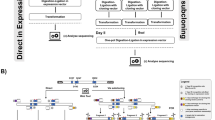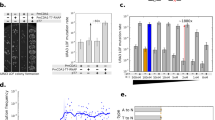Abstract
Deep mutational scanning is a foundational tool for addressing the functional consequences of large numbers of mutants, but a more efficient and accessible method for construction of user-defined mutagenesis libraries is needed. Here we present nicking mutagenesis, a robust, single-day, one-pot saturation mutagenesis method performed on routinely prepped plasmid dsDNA. The method can be used to produce comprehensive or single- or multi-site saturation mutagenesis libraries.
This is a preview of subscription content, access via your institution
Access options
Subscribe to this journal
Receive 12 print issues and online access
$259.00 per year
only $21.58 per issue
Buy this article
- Purchase on Springer Link
- Instant access to full article PDF
Prices may be subject to local taxes which are calculated during checkout

Similar content being viewed by others
Accession codes
Primary accessions
Sequence Read Archive
References
Fowler, D.M. & Fields, S. Nat. Methods 11, 801–807 (2014).
Hietpas, R.T., Jensen, J.D. & Bolon, D.N.A. Proc. Natl. Acad. Sci. USA 108, 7896–7901 (2011).
Firnberg, E., Labonte, J.W., Gray, J.J. & Ostermeier, M. Mol. Biol. Evol. 31, 1581–1592 (2014).
Melnikov, A., Rogov, P., Wang, L., Gnirke, A. & Mikkelsen, T.S. Nucleic Acids Res. 42, e112 (2014).
Stiffler, M.A., Hekstra, D.R. & Ranganathan, R. Cell 160, 882–892 (2015).
Klesmith, J.R., Bacik, J.P., Michalczyk, R. & Whitehead, T.A. ACS Synth. Biol. 4, 1235–1243 (2015).
Whitehead, T.A. et al. Nat. Biotechnol. 30, 543–548 (2012).
Kowalsky, C.A. et al. J. Biol. Chem. 290, 26457–26470 (2015).
Kowalsky, C.A. et al. PLoS One 10, e0118193 (2015).
Fowler, D.M., Stephany, J.J. & Fields, S. Nat. Protoc. 9, 2267–2284 (2014).
Kitzman, J.O., Starita, L.M., Lo, R.S., Fields, S. & Shendure, J. Nat. Methods 12, 203–206 (2015).
Firnberg, E. & Ostermeier, M. PLoS One 7, e52031 (2012).
Jain, P.C. & Varadarajan, R. Anal. Biochem. 449, 90–98 (2014).
Fowler, D.M. et al. Nat. Methods 7, 741–746 (2010).
Sambrook, J., Fritsch, E.F. & Maniatis, T. Molecular Cloning. (Cold Spring Harbor Laboratory Press, 1989).
Kunkel, T.A. Proc. Natl. Acad. Sci. USA 82, 488–492 (1985).
Chan, S.-H., Stoddard, B.L. & Xu, S.Y. Nucleic Acids Res. 39, 1–18 (2011).
Heiter, D.F., Lunnen, K.D. & Wilson, G.G. J. Mol. Biol. 348, 631–640 (2005).
Bienick, M.S. et al. PLoS One 9, e109105 (2014).
Fowler, D.M., Araya, C.L., Gerard, W. & Fields, S. Bioinformatics 27, 3430–3431 (2011).
Wrenbeck, E., Klesmith, J., Stapleton, J. & Whitehead, T. Protocol Exchange http://dx.doi.org/10.1038/protex.2016.061 (2016).
Li, H. & Durbin, R. Bioinformatics 26, 589–595 (2010).
Li, H. et al. Bioinformatics 25, 2078–2079 (2009).
Acknowledgements
We thank M. Ostermeier (John Hopkins University) for the oligo sets used in creation of the bla libraries. This research was partially supported by a fellowship from Michigan State University under the Training Program in Plant Biotechnology for Health and Sustainability (T32-GM110523 to E.E.W.), a Howard Hughes Medical Institute Gilliam fellowship (to A.A.), US Department of Agriculture National Institute of Food and Agriculture award 2016-67011-24701 (to J.R.K.), and the US National Science Foundation Career Award 1254238 CBET (to T.A.W.).
Author information
Authors and Affiliations
Contributions
E.E.W. and T.A.W. wrote the manuscript with input from all coauthors; E.E.W., T.A.W., J.R.K., and J.A.S. conceived the method; E.E.W., J.R.K., J.A.S., and T.A.W. devised experiments; E.E.W., J.R.K., and A.A. performed experiments; K.E.J.T. and A.A. tested the method.
Corresponding author
Ethics declarations
Competing interests
E.E.W., J.R.K., J.A.S. and T.A.W. have filed a provisional patent application covering this method (US provisional number 62/380,717).
Integrated supplementary information
Supplementary Figure 1 Gel snapshots along the optimized nicking mutagenesis method.
Plasmid dsDNA and ssDNA (prepared from bacteriophage) of pEDA5_GFPmut3 are included for size reference. NR = nicking reaction; 2 μg of pEDA5_GFPmut3_Y66H was placed in a 20 μL reaction with 10 U Nt.BbvCI in 1X CutSmart buffer. TP = template preparation; a reaction was ceased after the template preparation phase. MS = mutant strand; a reaction was ceased after the synthesis of the mutant strands, where regeneration of relaxed dsDNA can be seen. 1 kb Plus Ladder (Thermo Fischer Scientific, lane 1) included for size reference. Gel image has been cropped to size.
Supplementary Figure 2 Probability distribution of mutation counts in amiE comprehensive nicking mutagenesis libraries.
Dashed vertical lines represent median (red) and mean (blue) library member read coverage. Panel a shows distribution for reaction 1 and panel b shows the distribution for reaction 2.
Supplementary Figure 3 Comparison of the probability distributions of site-saturation mutagenesis libraries resulting from nicking mutagenesis or PFunkel mutagenesis.
Because the depth of sequencing coverage varied between the three methods, all samples were normalized to a 200-fold depth of coverage of possible single non-synonymous mutations. The expected library diversity is 820 for Kowalsky et al.1,2 and 1420 for amiE reaction 1 & reaction 2 (this work). a. Cumulative distribution function for the three libraries as a function of normalized sequencing counts. 91.7%, 93.2%, and 97.8% of the library is represented above a threshold of 10 sequencing counts for PFunkel library, amiE reaction 1, and the amiE reaction 2 libraries, respectively. b. Frequency is plotted as a function of sequencing counts for the same three libraries. The experimental data are plotted as symbols, with lines representing a best fit of the data using a log-normal distribution (PFunkel: μ=2, σ=0.49, amiE reaction 1: m=2, σ=0.50. amiE reaction 2: m=2, σ=0.44).
Supplementary Figure 4 Off-target mutational analysis of amiE input plasmid and mutational libraries by shotgun sequencing.
a-c. Percent mutant allele at each position in the plasmid sequence for the input plasmid (a) amiE reaction 1 library (b) and amiE reaction 2 library (c). Shotgun sequencing reads were aligned to the pEDA3_amiE plasmid using BWA aligner3,4 and the frequency of each base at each position was counted using bam-readcount (www.github.com). Percent mutant allele was calculated for each position by summing all non-wildtype allele counts and diving by total reads at that position. Overlain red curves indicate depth of sequencing coverage at each position. d-e. Background subtracted percent mutant allele for each position in plasmid sequence of amiE reaction 1 library (d) and amiE reaction 2 library (e).
Supplementary Figure 5 bla library coverage distributions.
Probability distribution of mutation counts in bla comprehensive nicking mutagenesis libraries. Dashed vertical lines represent median (red) and mean (blue) library member read coverage. b. Cumulative distribution function for the three libraries as a function of normalized sequencing counts.
Supplementary Figure 6 Schematic overview of single- or multi-site nicking mutagenesis.
After the preparation of an ssDNA template, an annealing reaction is set up with a single or mixed set of mutagenic oligos at a 5:1 primer:template ratio (for each oligo). Next, reagents and enzymes necessary to synthesize the mutant strands are added. The remainder of the protocol is identical to comprehensive nicking mutagenesis.
Supplementary information
Supplementary Text and Figures
Supplementary Figures 1–6, Supplementary Tables 1–4, Supplementary Note 1 and Supplementary Protocols 1 and 2. (PDF 1111 kb)
Rights and permissions
About this article
Cite this article
Wrenbeck, E., Klesmith, J., Stapleton, J. et al. Plasmid-based one-pot saturation mutagenesis. Nat Methods 13, 928–930 (2016). https://doi.org/10.1038/nmeth.4029
Received:
Accepted:
Published:
Issue Date:
DOI: https://doi.org/10.1038/nmeth.4029
This article is cited by
-
An orthogonalized PYR1-based CID module with reprogrammable ligand-binding specificity
Nature Chemical Biology (2024)
-
The energetic and allosteric landscape for KRAS inhibition
Nature (2024)
-
Positive epistasis drives clavulanic acid resistance in double mutant libraries of BlaC β-lactamase
Communications Biology (2024)
-
Boosting genome editing efficiency in human cells and plants with novel LbCas12a variants
Genome Biology (2023)
-
Antibody-directed evolution reveals a mechanism for enhanced neutralization at the HIV-1 fusion peptide site
Nature Communications (2023)



